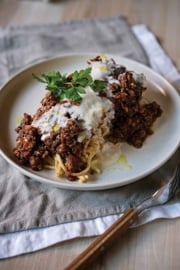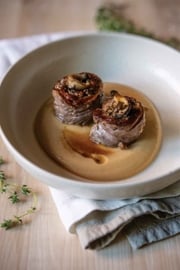Korean Barbecued Tofu and Vegetable Kebabs

A quick marinade readies the firm tofu cubes for a quick turn on the grill with an irresistible Korean-style glaze. Serve alone as an appetizer or as a meal on a bed of steamed brown rice or quinoa.
You will need 9 bamboo skewers for this recipe. Soak them in water for 15 minutes before use.
Marinade
1 cup (250 mL) hot water
1 Tbsp (15 mL) low-sodium soy sauce
|1/2 Tbsp (7 mL) low-sodium vegan chicken bouillon paste or powder
1/2 tsp (2 mL) dried rubbed sage
1/4 tsp (1 mL) dried thyme
1 small garlic clove, crushed
12 oz (350 g) firm or extra-firm tofu
Korean Barbecue Sauce
2 Tbsp (30 mL) low-sodium soy sauce
2 Tbsp (30 mL) Korean fermented hot red pepper paste (gochujang)
2 Tbsp (30 mL) agave nectar
2 tsp (10 mL) dark sesame oil
1 tsp (5 mL) unseasoned rice vinegar
1/2 tsp (2 mL) natural liquid smoke
1 small garlic clove, crushed
1/2 Tbsp (7 mL) toasted sesame seeds
Kebabs
1 medium onion
1 large green pepper
9 small button mushrooms
To make tofu marinade mix together water, soy sauce, bouillon paste or powder, sage, thyme, and garlic in 1 qt (950 mL) saucepan. Bring mixture to a boil.
Cut tofu in 36 - 1/2 in (1.25 cm) cubes. Add cubed tofu to marinade and lower heat to simmer. Simmer tofu for about 5 minutes.
Pour tofu and marinade together into shallow 1 qt (950 mL) heatproof baking dish or storage container. The liquid should cover the tofu. If not, stir or shake it a few times while it is cooling. Cover and refrigerate until cooking time.
Prepare vegetables for kebabs and make barbecue sauce while tofu marinates. Cut onion from end to end into 8 wedges; separate layers. Seed green pepper and cut into 1 in (2.5 cm) squares. Leave mushrooms whole.
To make Korean Barbecue Sauce, in small bowl mix together soy sauce with Korean red pepper paste, agave nectar, sesame oil, vinegar, liquid smoke, garlic, and sesame seeds.
When ready to cook, remove tofu cubes from marinade with slotted spoon and drain well. In shallow pan, mix tofu cubes with Korean barbecue sauce to coat all sides.
To make kebabs, thread tofu cubes on skewers, alternating them with green peppers, onion wedges, and mushrooms. Place kebabs back in pan with barbecue sauce while threading remaining skewers.
Unless grilling on a barbecue or indoor grill, set oven to broil. Place kebabs in a row on baking sheet. Brush tops of kebabs with barbecue sauce. Place baking sheet 4 to 6 in (10 to 15 cm) under heat source of broiler.
Broil until top of tofu starts to brown and char a bit around the edges. Keep an eye on them! Turn over kebabs; brush with more barbecue sauce and repeat, broiling second side.
When kebabs are broiled or grilled to your liking, serve alone as an appetizer or nestle two skewers over a small portion of steamed rice or quinoa, drizzle with remaining barbecue sauce, and serve immediately.
Makes 9 skewers.
Each skewer contains: 79 calories; 6 g protein; 4 g total fat (0.5 g sat. fat, 0 g trans fat); 7 g carbohydrates; 1 g fibre; 331 mg sodium
source: "Versatile Tofu", alive #356, June 2012




